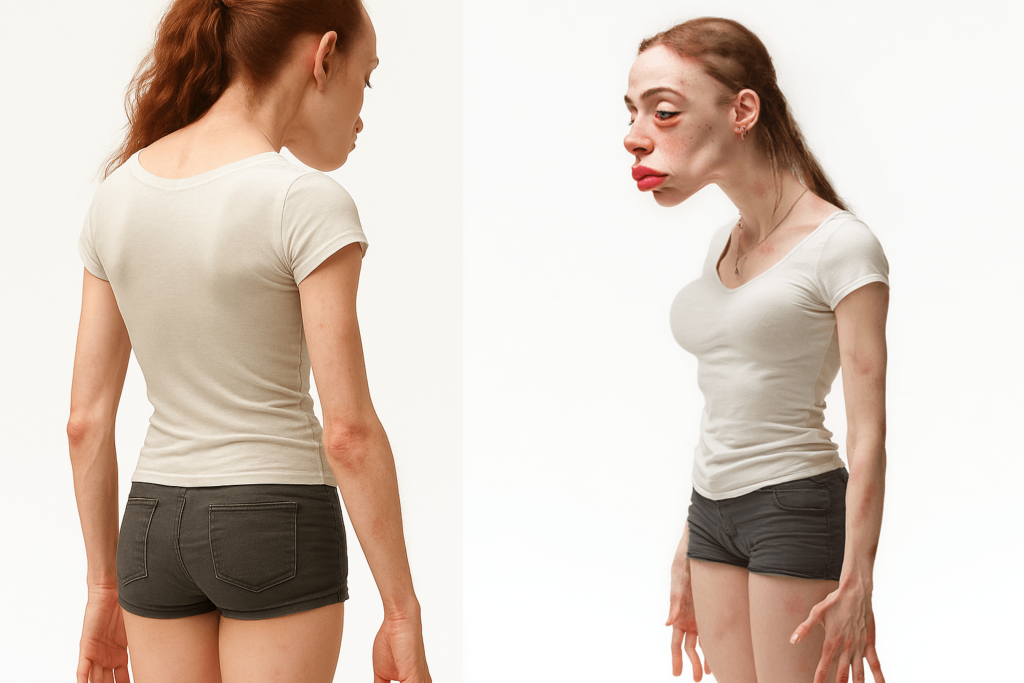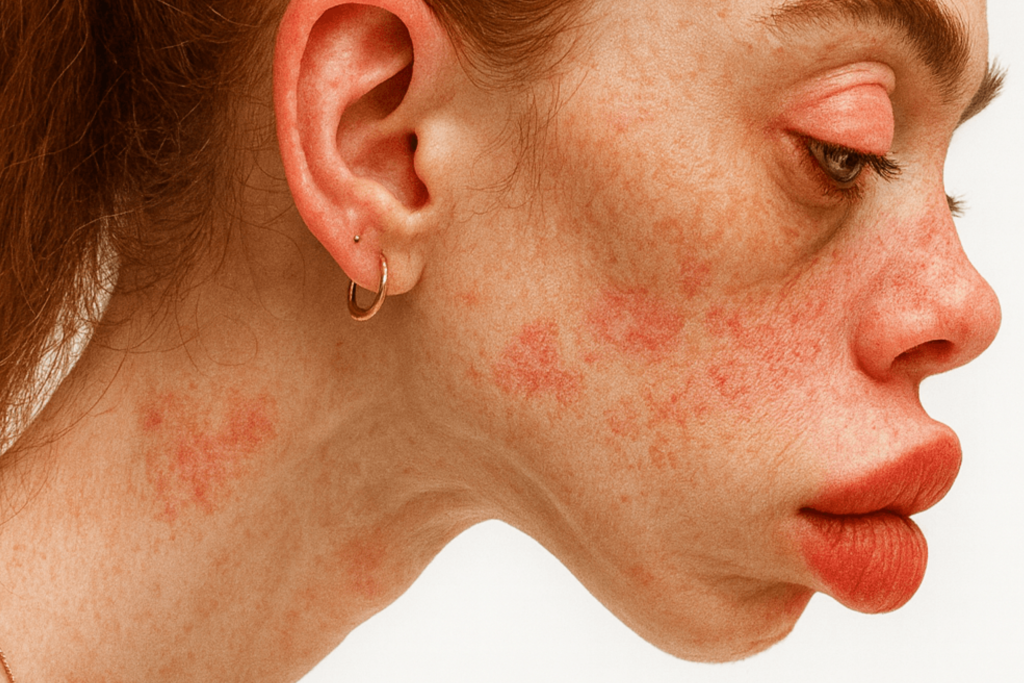Your cart is currently empty!
Ava 2050: The Chilling Glimpse Into the Future of Influencer Culture

It’s the nightmare no ring light can fix: the year is 2050, and the once-polished glow of influencer life has finally caught up. Forget perfectly curated feeds, the haunting AI model named Ava is here to remind us that even the most glamorous lifestyle has an expiration date. And trust us, it’s not filtered.
Ava, designed by Casino.org using medical research and lifestyle data, paints a shocking portrait of what decades of blue light, sleepless nights, tight hairstyles, cosmetic procedures, and endless screen time could do to the human body. She’s hunched, swollen-eyed, and sporting thinning hair, a ghostly before-and-after of the influencer dream.

The image is part satire, part science, and entirely unsettling. But it also asks us to reflect on a deeper question: if this is the potential future for influencers, what does it say about the rest of us glued to screens all day?
The Ghost of Christmas Future for Influencer Culture
Ava exists less as a jump scare and more as a public‑health diagram you can’t unsee. She is a stitched composite built from ergonomics, dermatology, and cosmetic‑medicine literature, then rendered onto a single body. By collapsing decades of micro‑choices into one frame, the project makes cumulative risk legible, an evidence‑based caricature designed to communicate fast.
What makes that warning specific to influencer culture is the system around it. Platforms reward frequency, recency, and appearance optimization; brands reward consistency and face‑time; audiences reward novelty. The job nudges creators toward constant camera‑readiness: standardized looks, recurring “maintenance” procedures to keep pace with trends, travel and logistics that privilege the shot over recovery, and device‑use patterns anchored to metrics. Any one choice is minor; in aggregate, they trace the silhouette you see in Ava.
Read this less as doom and more as diagnosis. Ava clarifies where interventions belong: occupational‑health standards for creator work, realistic production calendars, informed consent around elective touch‑ups, clearer labels for manipulated media, and platform incentives that stop penalizing rest. She serves as the genre’s Dickensian ghost, not in the sense of scolding but by forecasting that when the system changes, the body’s trajectory changes too.
Tech Neck and the Body That Scrolled Too Much
Ava’s exaggerated stoop dramatizes a condition clinicians already warn about: the cervical spine buckling under the sustained forward tilt of device use. The physics are straightforward: a head that weighs roughly five kilograms when upright can exert four to five times that force at steep angles. Over the years, this additional load compresses discs, stiffens surrounding musculature, and accelerates degenerative changes normally associated with aging. For creators, the intensity multiplies: shooting, editing, live-streaming, and endless interaction extend exposure far beyond typical office or leisure patterns.

The consequences are not just cosmetic slouching. Studies in biomechanics link chronic forward flexion with tension headaches, nerve impingement, and even compromised breathing efficiency as the ribcage collapses inward. What begins as a posture quirk evolves into a systemic stress that reduces energy, disrupts focus, and locks the body into maladaptive patterns. In Ava’s silhouette, those cumulative adjustments are exaggerated until impossible to ignore.
Her figure reminds us that posture is not an aesthetic preference but an infrastructure for health. Movement variety, ergonomic setups, and deliberate breaks are not luxuries but counterweights to a digital economy that asks us to bow our heads toward screens for hours on end. Ava embodies the endpoint when those counterweights never arrive: a spine molded by metrics rather than by motion.
The Hidden Grind Behind the Glam
The curated glow of influencer feeds often obscures a reality that more closely resembles shift work than leisure. Unlike traditional jobs with defined hours, influencer labor stretches across days and nights, dictated by unpredictable algorithms and brand demands. Ava’s worn expression and skin flare‑ups symbolize the physiological toll of this perpetual availability. When every outing can become content, rest ceases to exist as a separate category, and the body bears the cost of blurred boundaries.

The hidden grind extends beyond hours. Constant travel for shoots and events disrupts circadian rhythms; deadlines compress recovery time between cosmetic procedures; and the pursuit of novelty pressures creators to experiment with products at a pace dermatologists would deem unsafe. The financial unpredictability of sponsorship cycles compounds the stress, tying basic health decisions to follower counts and campaign renewals. In Ava’s depiction, this instability manifests as chronic fatigue etched into skin and posture.

Her image forces us to reconsider what the “freedom” of online fame truly entails. The absence of a boss does not equal the absence of pressure; instead, creators answer to a diffuse crowd of metrics and expectations that never sleep. The grind may be invisible to followers scrolling past another polished post, but Ava’s body displays it unmistakably: a ledger of small compromises made visible in cumulative form.
Influencer Culture’s Double Bind
Influencer culture turns into a paradox because it requires masking the long hours and physical strain behind a seamless image. A career built on constant production must simultaneously masquerade as leisure, creating a performance where exhaustion is airbrushed into ease. Ava’s distorted form captures that tension: her body testifies to relentless labor, while her imagined feed would still have to project nonchalance.
This double bind emerges from the mechanics of visibility. Algorithms reward steady posting and aesthetic polish, while audiences reward relatability and “authenticity.” The collision of those expectations leaves creators performing casualness under industrial conditions. They cannot look too manufactured without losing trust, yet they cannot step back from upkeep without losing reach. In Ava’s weary features, the contradiction becomes literal: a face stretched between opposing imperatives until it loses coherence.
Such a bind also narrows creative expression. Instead of experimenting freely, many creators remain locked into the tropes that maximize engagement, from beauty standards to posting rhythms. The result is an economy that exhausts individuality while punishing transparency about that exhaustion. Ava illustrates the endpoint of this trap: the costs accumulate in private, but the mask must stay public.
What Ava Really Means for Us
Ava’s significance extends beyond a projection of influencer health decline; she embodies a cultural mirror reflecting how digital life reshapes society as a whole. Her exaggerated features symbolize the cost of treating constant connectivity as normal, a pattern shared not only by creators but by anyone living under the pressure of notifications, curated identities, and the demand to remain visible.
Seen this way, Ava is less a grotesque curiosity and more an indictment of systemic forces. Social platforms optimize for attention at the expense of balance, advertising cycles reward unbroken visibility, and cultural narratives equate being seen with being valued. Within that framework, individuals internalize the expectation to always be “on,” while the infrastructure quietly extracts health, rest, and focus. Ava illustrates where that logic leads if left unchecked.

Her real warning lies in policy and culture rather than personal posture tips. She challenges us to ask how workplaces, schools, and families adapt norms around screen use; how governments regulate addictive design; and how communities can redefine success away from perpetual exposure. Ava’s lesson is not that we will all look like her, but that without systemic change we risk normalizing her condition as the baseline of digital life.
Tips for a Healthier Digital Life
For a general audience that spends long hours online, whether creating, working, or simply scrolling, Ava’s warning can be translated into practical steps:
- Set screen-time boundaries: Use app timers or scheduled “offline” blocks to break the cycle of endless scrolling.
- Prioritize ergonomics: Adjust monitor height, invest in supportive seating, and use reminders to stretch every 30–60 minutes.
- Filter product choices: Be skeptical of constant “try-on” culture; stick with products you trust instead of chasing every new release.
- Practice digital rest: Designate tech-free zones at home, such as the dinner table or bedroom, to rebuild separation between online and offline life.
- Redefine success: Measure personal wellbeing by rest, creativity, or relationships rather than likes or follower counts.
A Future We Can Still Rewrite
Ava might look like a horror story, but she’s not destiny. She’s a cautionary tale, part satire, part science, meant to jolt us into seeing the physical and mental costs of always being online.
Influencers may be the most extreme example, but in truth, many of us are living our own mini-Ava journeys every time we scroll instead of sleep, hunch instead of stretch, or chase the dopamine hit of likes instead of balance.
If the influencer dream ends in Ava, maybe the rest of us should take note. Because the scariest part of this viral image isn’t Ava’s face. It’s the fact that she looks just a little too familiar already.
Featured Image from Casino.org
